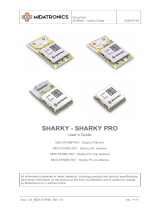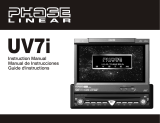Page is loading ...

FCC Compliance Statement
NOTE: This equipment has been tested and found to comply with
the limits of Part 15 of the FCC Rules. These limits are designed to
provide reasonable protection against harmful interference in a
residential installation. This equipment generates, uses and can radiate
radio frequency energy and, if not installed in accordance with the
instructions, may cause harmful interference to radio communications.
However, there is no guarantee that interference will not occur
in a particular installation. If this equipment does cause harmful
interference to radio or television reception, which can be determined
by turning the equipment o and on, the user is encouraged to try to
correct the interference by one or more of the following measures:
- Reorient or relocate the receiving antenna.
- Increase the separation between the equipment and receiver.
- Connect the equipment into an outlet on a circuit dierent from
that to which the receiver is connected.
- Consult the dealer or an experienced radio/TV technician for help.
Any changes or modications not expressly approved by the party
responsible for compliance could void the user’s authority to operate
this equipment.
Safety Considerations
1. Read the Instructions – All safety and operating instructions should
be read before using this product.
2. Retain the Instructions – These instructions should be retained for
future reference.
3. Heed Warnings and Instructions – All warnings and instructions
should be followed.
4. Water and Moisture - This device should NOT be used near water,
such as a bathtub, washbowl, sink, laundry tub, in a wet basement,
near a swimming pool, etc.
5. Ventilation – While this device does not require specic ventilation
considerations, it should NOT interfere with ventilation of other
components.
6. Heat and Flames – This device should be situated away from heat
sources such as radiators, heat registers, stoves, replaces, or other
devices that produce heat.
7. Power Sources – Only used the supplied AC power adaptors to
power this product.
8. Power Cord Protection – Power supply cords should be routed so
that they are not likely to be walked on or pinched by items placed
upon or against them, paying particular attention to cords at plugs,
convenience receptacles, and the point where they exit the device.
9. Cleaning – Clean only with a dry cloth. Unplug power cords from
wall outlet before cleaning.
10. Nonuse Periods – The power adaptor cords should be unplugged
from the outlet when left unused for long periods of time.
11. Lightning and Power Surges – We recommend that you disconnect
the device from the electrical outlet during electrical storms and/or
recurring power interruptions.
12. Object or Liquid Entry – Care should be taken so that objects
do not fall on and liquids are not spilled onto the device. Do not
expose the device to dripping or splashing from liquids. Do not
place objects lled with liquids on top of, or near the device, for
example: ower vases, beverages, liquid-lled lamps, etc.
13. Overloading – Do not overload wall outlets, extension cords, or
outlet strips as this can result in a risk of re or electrical shock.
14. Servicing - Do not attempt to service the device beyond what is
described in the operating instructions. All other servicing should
be referred to qualied personnel only.
Introduction
Thank you for purchasing a JLINK TRX wireless audio system. This
product has been critically engineered to deliver exceptional
performance in your audio system or home theater for many years to
come. Please read this manual thoroughly to correctly integrate and
achieve the highest level of performance.
What’s Included
(1) JLINK TX Transmitter
(1) JLINK RX Receiver
(2) AC Power Adaptors
(1) JLINK Port Connection Cable (3 ft.)
(1) Hook & Loop Fastener Tape
(1) User Manual
Product Overview & Features
The JLINK TRX system uses state-of-the-art wireless technology to send
audio signals up to 100 feet away (30 meters). Broadcasting at an ultra-
high frequency of 2.4 GHz, the JLINK TRX delivers crystal-clear, stereo
sound anywhere throughout your home.
Features include:
- Bit-Perfect PCM Stereo Digital Wireless Technology (16 bit / 48 kHz)
- RCA-type input/output connectors compatible with most audio
equipment
- Up to 4 JLINK receivers can be paired to each JLINK transmitter
(additional receivers sold separately)
- Up to 3 JLINK transmitters can be used concurrently (3 output
channels to choose from)
- JLINK receiver includes JLINK port for compatible JL Audio products
- Low-Power Sleep mode after 30 minutes of inactivity
Placement Considerations:
The transmitter and receiver modules may be situated in any position,
however their placement should be away from heat generating
sources, such as amplier or receiver heat sinks. Also ensure that each
module’s placement does not interfere with the ventilation of other
components.
Although mounting is not necessary, you may use the supplied hook
& loop fastener tape to ax the modules to a at surface on a cabinet
wall, rack or component. If you choose not to mount the modules,
make sure they are placed on a at, stable surface to prevent damage
from falling.
Connecting the Transmitter
1. Select the source device that you wish to transmit audio signal from
and power OFF that device.
2. Connect the JLINK transmitter’s RCA line inputs to your source
device’s RCA line outputs.
3. Plug the smaller end of the AC power adaptor into the transmitter’s
power jack. Plug the larger end of the AC power adaptor into a
standard A/C wall outlet.
4. Using the bottom-mounted switch, select one of three output
channels to broadcast your audio signal. Note: The transmitter and
receiver need to be set to the same channel.
Connecting the Receiver – Option A
(when using RCA connections)
1. Select the device that you wish to send the audio signal to and
power OFF that device.
2. Connect the JLINK receiver’s RCA line outputs to your device’s RCA
line inputs.
3. Plug the smaller end of the AC power adaptor into the receiver’s
power jack. Plug the larger end of the AC power adaptor into a
standard A/C wall outlet.
4. Set the receiver’s bottom-mounted switch to the same channel as
the transmitter.
Connecting the Receiver – Option B
(when using JLINK port)
1. Select the JLINK compatible device that you wish to send the audio
signal to and power OFF that device.
2. Set the receiver’s bottom-mounted switch to the same channel as
the transmitter.
3. Plug one end of the supplied cable into the JLINK receiver’s JLINK
port. Plug the other end of the cable into the JLINK port of the
compatible device. The JLINK receiver will transfer its audio signal
and receive its power connection directly through this cable. Note:
When connected in this manner, the JLINK receiver’s AC power
jack and RCA output connections should NOT be used.
Wireless, High-Fidelity Audio Transmitter & Receiver System

LED Status Indicator
A green LED light is located next to the power jack on the transmitter
and receiver to indicate each module’s status. Refer to the following
tables for its function and meaning.
LED Status - Transmitter
Action LED Function Mode
When rst connected
to power
3 rapid blinks, 1
long blink, OFF
Startup
Audio signal detected ON Begin RF link
No audio signal detected OFF Standby
No audio signal for 30
minutes
OFF Low Power Sleep*
*Transmitter will reawaken when audio is detected again.
Note: Plugging RCA cables in to the transmitter without a source
connected will cause LED on transmitter and receiver to turn ON.
LED Status - Receiver
Action LED Function Mode
When rst connected
to power
3 rapid blinks,
OFF
Startup
Audio signal detected ON RF link established
With RF link, no audio
signal detected
1 ash every 3
seconds
Standby
With RF link, no audio
signal for 30 minutes
OFF Low Power Sleep*
*Receiver will reawaken when audio is detected again.
Specications - System
S/N Ratio 80 dB @ 1 kHz, 500 mV
THD+N 0.02% @ 1 kHz, 500 mV
Crosstalk >75 dB @ 1 kHz, 500 mV
Frequency Response 16 Hz – 22 kHz (+0, -1dB)
Wireless Range 100 feet / 30 meters (typical)
Wireless Channels 3 available, selectable via switch
Latency 14 mS
Operating Temperature 32 to 104 °F / 0 to 40 °C
AC Power Adaptor 1 A, 5 volts DC
Specications - Transmitter
Inputs Analog, left and right RCA-type
Input Impedance 25 kΩ
Outputs
Bit-Perfect PCM Stereo Digital via
2.4 GHz Wireless
Receivers Supported Up to 4
Bit Depth/Sample Rate 16 Bit / 48 kHz
Power Requirements 200 mA, 5 volts (via AC adaptor)
Dimensions
3.5 in x 3.5 in x 1.12 in
89 mm x 89 mm x 28.5 mm
Specications - Receiver
Inputs
Bit-Perfect PCM Stereo Digital via
2.4 GHz Wireless
Outputs
Analog, left & right RCA-type or
Analog via JLINK port to compatible
product
Output Impedance 250 Ω
Full Scale
Output Voltage
1.2 V
Power Requirements
100 mA, 5 volts (via AC adaptor or
JLINK port
Dimensions
3.5 in x 3.5 in x 1.12 in
89 mm x 89 mm x 28.5 mm
Limited Warranty / Service Information
JL AUDIO warrants this product to be free of defects in materials
and workmanship for a period of three (3) years from the original date
of purchase.
Damage caused by the following is not covered under warranty:
accident, misuse, abuse, product modication or neglect, failure
to follow installation instructions, unauthorized repair attempts,
misrepresentations by the seller. This warranty does not cover
incidental or consequential damages and does not cover the cost of
removing or reinstalling the unit(s) or shipping the unit(s) to JL Audio
for service. Cosmetic damage due to accident or normal wear and
tear is not covered under warranty.
This warranty is not transferable and applies only to the original
purchaser of the product from an authorized JL AUDIO dealer.
Warranty is voided if the factory-applied product serial number is
removed or defaced.
Should service be necessary under this warranty for any reason
due to manufacturing defect or malfunction, JL AUDIO will, at its
discretion, repair or replace the defective product with new or
remanufactured product at no charge.
Any applicable implied warranties are limited in duration to the
period of the express warranty as provided herein beginning with
the date of the original purchase at retail, and no warranties, whether
express or implied, shall apply to this product thereafter. Some
states do not allow limitations on implied warranties, therefore these
exclusions may not apply to you. This warranty gives you specic
legal rights, and you may also have other rights which vary from state
to state.
If you need service on your JL AUDIO product:
All warranty returns should be sent to JL AUDIO freight prepaid
through an authorized JL AUDIO dealer and must be accompanied by
proof of purchase (a copy of the original sales receipt.) Direct returns
from consumers or non-authorized dealers will be refused unless
specically authorized by JL AUDIO with a valid return authorization
number. Warranty expiration on products returned without proof
of purchase will be determined from the manufacturing date code.
Coverage may be invalidated as this date is previous to purchase date.
Return only defective components. Non-defective items received
will be returned freight-collect. Customer is responsible for shipping
charges and insurance in sending the product to JL AUDIO. Freight
damage on returns is not covered under warranty. Always include
proof of purchase (sales receipt).
For Service Information in the U.S.A. please call:
JL Audio customer service:
(954) 443-1100 during normal business hours (Eastern Time)
JL Audio, Inc • 10369 North Commerce Parkway, Miramar, FL 33025
International Warranties:
Products purchased outside the United States of America are covered
only by that country’s distributor and not by JL Audio, Inc.
WARNING: THIS PRODUCT CONTAINS NO USER-SERVICEABLE PARTS.
PRODUCT IN WHICH DISASSEMBLY, REPAIR AND/OR MODIFICATION
HAS BEEN ATTEMPTED BY UNAUTHORIZED PARTIES WILL NOT BE
COVERED UNDER WARRANTY.
03-10-2015 Rev. 1 • Printed in China
/

